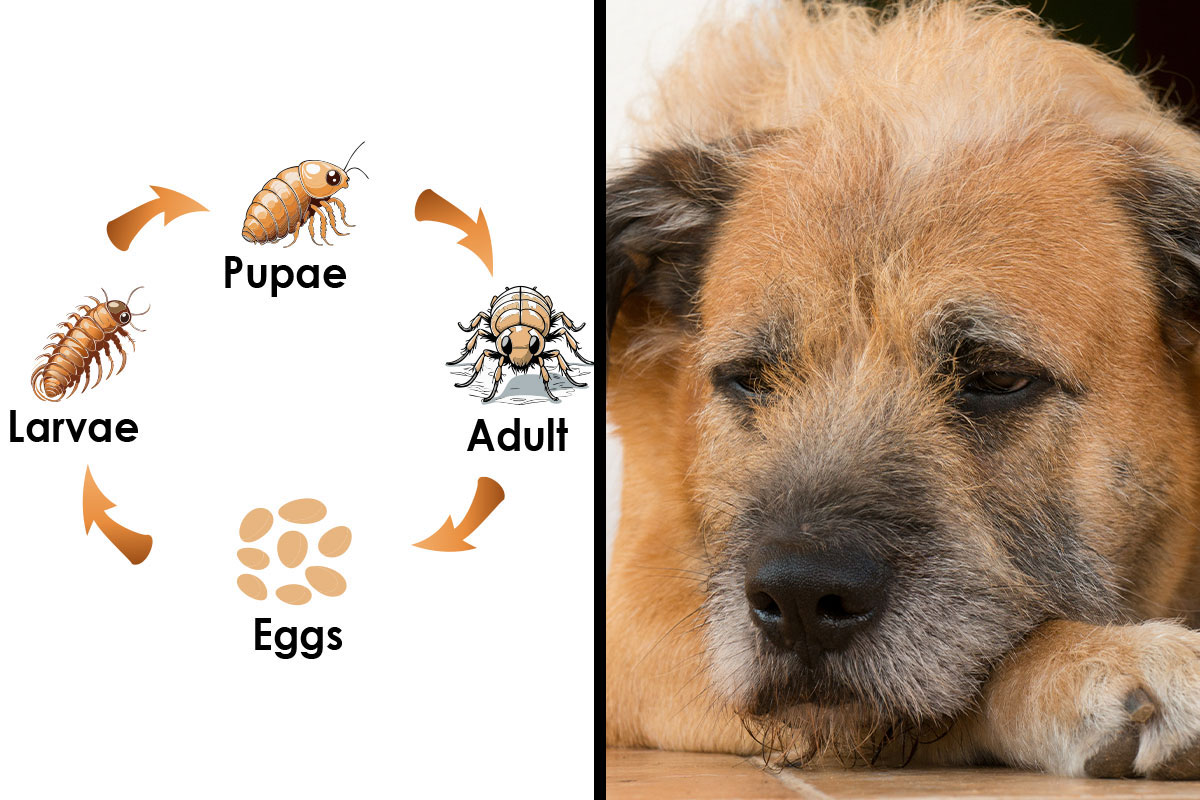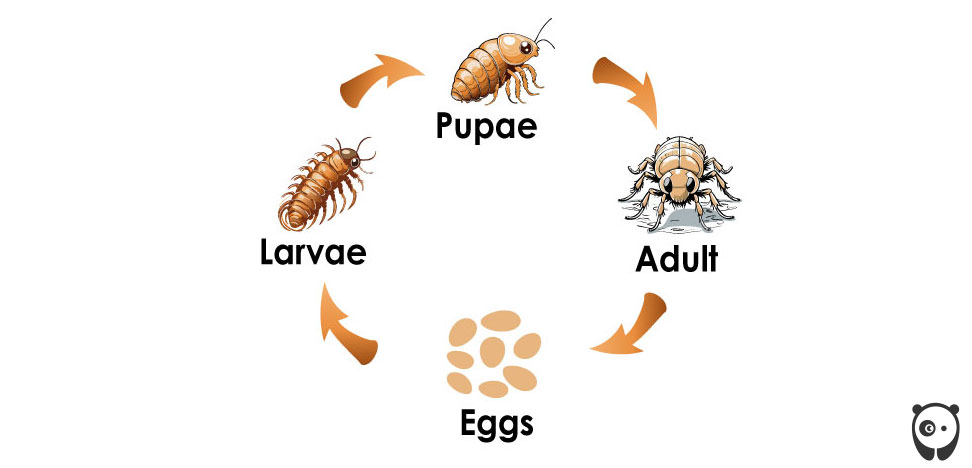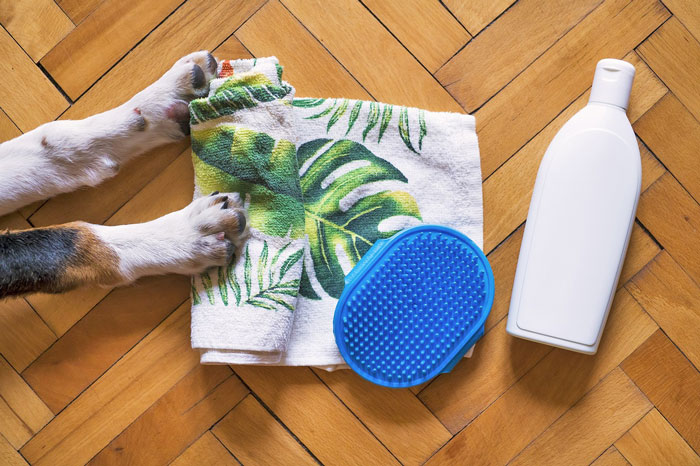
What Do Flea Eggs on Dogs Look Like and How to Get Rid of Them
As the spring season starts & the sun makes our backyards warmer, pet owners look forward to spending more time outside with their furry friends. However, this pleasant weather also signals a less welcome phenomenon – the hatching of flea eggs. And these turn our backyards into breeding grounds for these tiny, resilient pests. Fleas can multiply really fast. A single flea can lead to a huge problem before you know it. And, their tiny size and the hardiness of their eggs often leave pet parents unaware until it’s too late. Just imagine, in the cozy warmth of your home, flea eggs find the perfect haven to thrive – making them a formidable foe in pet care. What’s more? flea eggs can be hard to get rid of because they can resist many usual treatments. However, dealing with these small enemies isn’t as hard as it might seem.
- Flea eggs look like tiny grains of rice, hard to see due to their size (0.5 mm) and can be white to see-through.
- A single female flea can lay over 2,000 eggs in her lifetime, spreading them across carpets, bedding, and grass.
- Effective flea egg elimination involves using flea shampoos, flea combs, topical medications, and household cleaning.
- Only 5% of fleas are on pets; the rest are in the environment, highlighting the importance of treating both pets and home.
So keep reading to learn about the best ways to fight off the eggs of these annoying pests & keep your pets healthy and happy.
The information provided herein is for informational purposes only. Please refer to our disclaimer for more details..
Understanding the Flea Life Cycle
When it comes to flea infestation, a comprehensive understanding of their life cycle is vital for the effective eradication and prevention of fleas and flea eggs. Fleas, which can be a big problem for your animals, go through four main stages in their life. And each stage needs different ways to handle them. Let’s dive into their life cycle stages:
Stage 1: Flea Eggs
It all starts when female fleas lay eggs after they’ve had a meal of your pet’s blood. Contrary to common belief, human blood isn’t suitable for flea reproduction – thus, exclusively flea bites animals like dogs and cats. And, after eating, a female flea can lay over 2,000 eggs in her lifetime (up to 40 to 50 eggs per day), which is about one to two months. These eggs get laid in your pet’s fur but quickly spread around your home, like on:
- Carpets
- Bedding
- And even outside in the grass.
How much the eggs spread depends on things like how long your pet’s fur is and how much they move around. And, the number of eggs a flea lays can be affected by what the flea eats, the temperature around them & whether there are pesticides in the environment.
Stage 2: Flea Larvae
Flea eggs hatch into larvae in about 1 to 10 days, depending on how warm and humid it is. And they like it best at 75 to 85 degrees Fahrenheit with about 50 percent humidity. Larvae hide from light and stay in dark, damp places like carpets or under furniture. They eat organic stuff, including the flea feces & can grow up to 5mm long.
Stage 3: Flea Pupae
The next transformation is into pupae, encased in a silk-like cocoon. This stage can last from a week to several months as they wait for the right moment & a host to come by. These cocoons are tough against insecticides, making this stage hard to deal with. That’s why fleas can sometimes come back even after you’ve treated your home.
Stage 4: Adult Fleas
Adult fleas come out of the cocoons and need to feed on a host quickly. Once they find a host, like your pet, they start feeding and laying eggs. Treating your pets well is important to control flea numbers – as adult fleas spend most of their time on animals. And so, the cycle starts again with these new fleas laying more eggs.
The Centers for Disease Control points out that a flea’s growth from egg to adult depends a lot on the weather. Fleas do well in warm places and might not survive cold weather. In the right conditions, a flea can go from egg to adult in just two weeks. Surprisingly, only 5% of fleas are actually on your pet; the rest are spread out in your home & yard.
What Do Flea Eggs Look Like? Flea Eggs vs Dandruff vs Flea Dirt
Knowing what flea eggs look like is key to dealing with flea problems in pets. These eggs are super tiny, almost like tiny grains of rice. They’re oval-shaped and usually no bigger than 0.5 mm, about the size of a grain of sand or salt. And, their color can be bright white to off-white or even see-through – which makes them tough to see on light surfaces.
- Comparison with Dandruff: Flea eggs are uniformly oval, unlike the irregular shape of dandruff flakes. Unlike dandruff that sticks to pet hair, flea eggs tend to slip off & spread around more.
- Comparison with Flea Dirt: It’s crucial to differentiate flea eggs from flea dirt (the feces and dried blood from adult fleas). Flea dirt looks like little specks of black pepper & sticks to your pet’s fur and skin. But flea eggs are more like salt and scatter around more.
Spotting flea eggs is a big step in dealing with fleas, a major part of keeping your pets and home free from fleas.
How To Identify Flea Eggs on Dogs and Cats?
Finding flea eggs on your pet can be tricky, especially if they have light fur. Since flea eggs fall off pets pretty easily, you usually won’t see many on your pet at once. But, there are ways to check for them.
Firstly, a magnifying glass is an invaluable tool. Start by looking in spots where fleas like to hang out, such as:
- The back end
- The base of the tail
- The neck’s back
- And between the shoulder blades
Check these areas for eggs of fleas on your pet and also where your pet likes to relax – using the magnifying glass for a better look.
A flea comb is another essential tool if you suspect that your dog has fleas and fleas eggs. The comb’s teeth are really close together, perfect for catching those tiny white eggs. Be gentle but make sure to comb through all the fur so you can see the skin underneath. And it’s best to do this outside so you don’t end up spreading the eggs inside your house. While it might be a bit easier to comb flea eggs out of a cat’s softer fur, finding and getting them out of a dog’s coat can be more of a challenge.
How To Get Rid of Flea Eggs?
Flea egg removal involves a two-step approach: Initially, eradicate eggs & adult fleas on dogs, followed by the elimination of flea eggs within your household environment.
1. Removing Flea Eggs From Pets
Getting flea eggs off your pets is super important to stop fleas from spreading. Start by visiting your vet, who can tell how severe the flea infestation is and suggest the best treatments for your pet.
- Use Flea Shampoo: Pick a flea shampoo that’s right for your pet’s type. First, wet your pet’s fur with warm water to help loosen any eggs and fleas. And then apply the shampoo all over your pet, making sure it touches the skin. Allow the shampoo to sit for a minute to maximize its effectiveness – then rinse thoroughly. Be careful not to get shampoo in your pet’s eyes or mouth because it can irritate them.
- Flea Comb Method: After the bath, use a flea comb to carefully pick out any leftover eggs. Comb from the head to the tail, following the fur’s direction. And, pay extra attention to areas where the skin folds like the face, ears, neck & base of the tail. Clean the comb in hot, soapy water as you go to get rid of the eggs and fleas. If you’re doing this inside, remember to vacuum right after to catch any eggs that fall off. Remember, persistence is key. So keep combing your pet for a few days even if you think you’ve got all the fleas, just to be sure. Following these steps diligently will significantly aid in eliminating flea eggs & contribute to a flea-free pet.
- Topical Flea Medications: These treatments are really good for fighting flea eggs. Look for products with an ingredient called an insect growth regulator (IGR) – which targets the eggs specifically. Ingredients like permethrin, imidacloprid, or dinotefuran are common in these treatments & can kill adult fleas and stop eggs and larvae from growing. Brands like Frontline®, Revolution®, and Vectra® are put right on your pet’s skin. These treatments spread among fleas, killing adults and halting the hatching of new fleas. The US Food and Drug Administration says to make sure you’re using the right kind of medications for your pet’s age and size and to follow the directions carefully. And it’s important to know your pet’s exact weight to avoid overdosing. So using these treatments regularly, usually every month, is important to keep fleas away.
- Oral/Chewable Flea Treatments: Another good option is oral meds, which are often chewable tablets. They work from the inside to kill fleas and ticks just hours after your pet takes them. Examples include Comfortis® and Trifexis®, administered monthly, and isoxazolines like Simparica™, NexGard®, and Bravecto®. They kill adult fleas fast, within 24 hours of your pet coming into contact with fleas, and keep working until the next dose. These chewables are mainly for dogs, but Bravecto® also has a topical solution for both dogs and cats.
Note: Remember, while this information is helpful in removing flea eggs from pets, it’s crucial to prioritize consulting your veterinarian. They can properly diagnose the severity of the infestation, recommend the safest and most effective treatment plan for your specific pet, and ensure their overall health and well-being throughout the process.
2. Killing Flea Eggs in Your Home
Removing flea eggs from your house takes a bit of work, but it’s doable with the right steps. Here’s how you can tackle the problem:
- Wash All Fabrics: Start by cleaning anything fabric that your pet hangs out on. This includes their bedding, blankets, curtains, cushion covers & even pet toys. Wash them in hot water with detergent or bleach, and then dry them on the highest heat the fabric can handle. And, doing this regularly, especially for your pet’s bedding and toys, is important – because flea larvae hatch over time. Keep anything you’ve cleaned in a place where fleas can’t get to it to avoid it getting re-infested.
- Vacuum Everything: Vacuuming is a great way to get flea eggs out of places you can’t wash, like carpets and furniture. Use a vacuum that’s got good suction and a brush that spins, focusing on spots your pet likes to be. And make sure to vacuum under furniture and in all the corners where eggs might be hiding. Before vacuuming, consider placing mothballs in the vacuum bag to kill eggs & fleas sucked up during cleaning. Always throw out the vacuum bag right after you use it so any eggs inside don’t hatch.
- Steam Clean: For fabrics and carpets that can’t be washed, use steam cleaning to kill fleas and their eggs. The steam needs to be at least 95°F (35°C) to work. Go over the area slowly to make sure you cover it all. After it’s dry, vacuum again to pick up any dead fleas or eggs.
- Use Insect Growth Regulators (IGRs): IGRs stop flea eggs and larvae from growing into adult fleas. These products act like hormones that keep fleas from getting to the next stage in their life cycle, including making eggs hatch. You can sprinkle food-grade diatomaceous earth or spray IGRs on carpets, furniture, and baseboards. Be careful with diatomaceous earth, though, because it can be harmful if breathed in or if it gets on your pet. Always follow the directions on how to use them safely.
- Use Insecticides for Serious Problems: If you have a severe infestation, especially with wall-to-wall carpeting, think about using insecticides that have both an adulticide (adult-killing chemical) and an IGR. And, always wear gloves & make sure both pets and people are out of the area until everything has dried.
- Take Care of Your Yard: Cut your grass short and clean up any leaves or debris. This makes it less likely for your pet to get fleas from outside. You could hire pest control for your garden, but that might upset the balance of your yard’s natural environment. A natural way to keep fleas away is by spreading cedar chips where your pet hangs out – as fleas don’t like the smell. Sulfur, either as a powder or liquid, can also help keep fleas away and stop eggs from hatching.
- Manage Wildlife: Wild animals can bring fleas into your yard. Try to keep them away by using fences, bright lights, loud sounds, or rags soaked in cider vinegar. These steps can encourage wildlife to stay away, lowering the chance of fleas getting into your home.
- Get Professional Help: If fleas keep coming back, especially if you have a lot of carpets, it might be time to call in the pros. Pest control services can offer treatments and advice tailored to your home. Be cautious with flea foggers; they can be hazardous, especially in homes with fish tanks. Cover your tanks and get ready to clean everything in your home, like bedding, clothes & kitchen surfaces, after using a fogger.
Staying consistent and thorough is the best way to get rid of flea eggs in your home. Regular cleaning, vacuuming, and using the right flea-control methods will help make sure your home is free of fleas.
Conclusion
Understanding and tackling flea eggs is paramount for every dog enthusiast and future dog owner. And, as we’ve talked about, removing these tiny pests isn’t easy. But with the right know-how and tools, you can keep your furry buddies & your home free from fleas. Remember, fleas aren’t just annoying; they can be harmful to your precious pets and mess with the peace of your home. By learning about how fleas live and grow and using the methods we’ve discussed – you’re taking a big step in being a responsible pet owner. The best ways to fight fleas are:
- Regularly grooming your pet
- Keeping your house clean
- And using the right flea treatments
So stay on top of things, take action early, and make sure your dog lives in a safe, flea-free space. Your effort shows how much you care about your pet and your commitment to keeping your home happy & healthy.
217views
Share on Facebook
 Image credits:
Image credits:  Image credits:
Image credits: 


-4
0